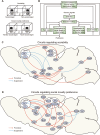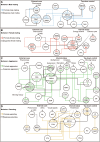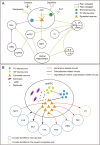Brain circuits that regulate social behavior
- PMID: 40287553
- PMCID: PMC12185352
- DOI: 10.1038/s41380-025-03037-6
Brain circuits that regulate social behavior
Abstract
Social interactions are essential for the survival of individuals and the reproduction of populations. Social stressors, such as social defeat and isolation, can lead to emotional disorders and cognitive impairments. Furthermore, dysfunctional social behaviors are hallmark symptoms of various neuropsychiatric disorders, including autism spectrum disorder (ASD) and post-traumatic stress disorder (PTSD). Consequently, understanding the neural circuit mechanisms underlying social behaviors has become a major focus in neuroscience. Social behaviors, which encompass a wide range of expressions and phases, are regulated by complex neural networks. In this review, we summarize recent progress in identifying the circuits involved in different types of social behaviors, including general social investigation, social preference, mating, aggression, parenting, prosocial behaviors, and dominance behaviors. We also outline the circuit mechanisms associated with social deficits in neuropsychiatric disorders, such as ASD, schizophrenia, and PTSD. Given the pivotal role of rodents in social behavior research, our review primarily focuses on neural circuits in these animals. Finally, we propose future research directions, including the development of specific behavioral paradigms, the identification of circuits involved in motor output, the integration of activity, transcriptome, and connectome data, the multifunctional roles of neurons with multiple targets, and the interactions among multiple brain regions.
© 2025. The Author(s).
Conflict of interest statement
Competing interests: The authors declare no competing interests.
Figures





Similar articles
-
Pre-deployment programmes for building resilience in military and frontline emergency service personnel.Cochrane Database Syst Rev. 2021 Dec 6;12(12):CD013242. doi: 10.1002/14651858.CD013242.pub2. Cochrane Database Syst Rev. 2021. PMID: 34870330 Free PMC article.
-
Differently different?: A commentary on the emerging social cognitive neuroscience of female autism.Biol Sex Differ. 2024 Jun 13;15(1):49. doi: 10.1186/s13293-024-00621-3. Biol Sex Differ. 2024. PMID: 38872228 Free PMC article. Review.
-
How lived experiences of illness trajectories, burdens of treatment, and social inequalities shape service user and caregiver participation in health and social care: a theory-informed qualitative evidence synthesis.Health Soc Care Deliv Res. 2025 Jun;13(24):1-120. doi: 10.3310/HGTQ8159. Health Soc Care Deliv Res. 2025. PMID: 40548558
-
Behavioral interventions to reduce risk for sexual transmission of HIV among men who have sex with men.Cochrane Database Syst Rev. 2008 Jul 16;(3):CD001230. doi: 10.1002/14651858.CD001230.pub2. Cochrane Database Syst Rev. 2008. PMID: 18646068
-
Methylphenidate for children and adolescents with autism spectrum disorder.Cochrane Database Syst Rev. 2017 Nov 21;11(11):CD011144. doi: 10.1002/14651858.CD011144.pub2. Cochrane Database Syst Rev. 2017. PMID: 29159857 Free PMC article.
Cited by
-
Early Life Social Isolation Dysregulates Social Reward Processing, BDNF Signaling, and Intracellular Vesicular Sorting in the Nucleus Accumbens of Male and Female Rats.J Neurochem. 2025 Aug;169(8):e70181. doi: 10.1111/jnc.70181. J Neurochem. 2025. PMID: 40762328 Free PMC article.
References
-
- Crespi BJ. The evolution of social behavior in microorganisms. Trends Ecol Evol. 2001;16:178–83. - PubMed
-
- Ebstein RP, Israel S, Chew SH, Zhong S, Knafo A. Genetics of human social behavior. Neuron. 2010;65:831–44. - PubMed
-
- Ciano Albanese N, Poggini S, Reccagni A, Barezzi C, Salciccia C, Poleggi A, et al. Adolescent social isolation induces sex-specific behavioral and neural alterations. Psychoneuroendocrinology. 2025;172:107264. - PubMed
-
- Trachtenberg E, Ruzal K, Sandbank E, Bigelman E, Ricon-Becker I, Cole SW, et al. Deleterious effects of social isolation on neuroendocrine-immune status, and cancer progression in rats. Brain Behav Immun. 2025;123:524–39. - PubMed
Publication types
MeSH terms
Grants and funding
LinkOut - more resources
Full Text Sources

